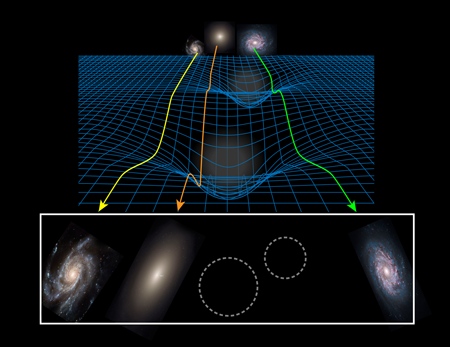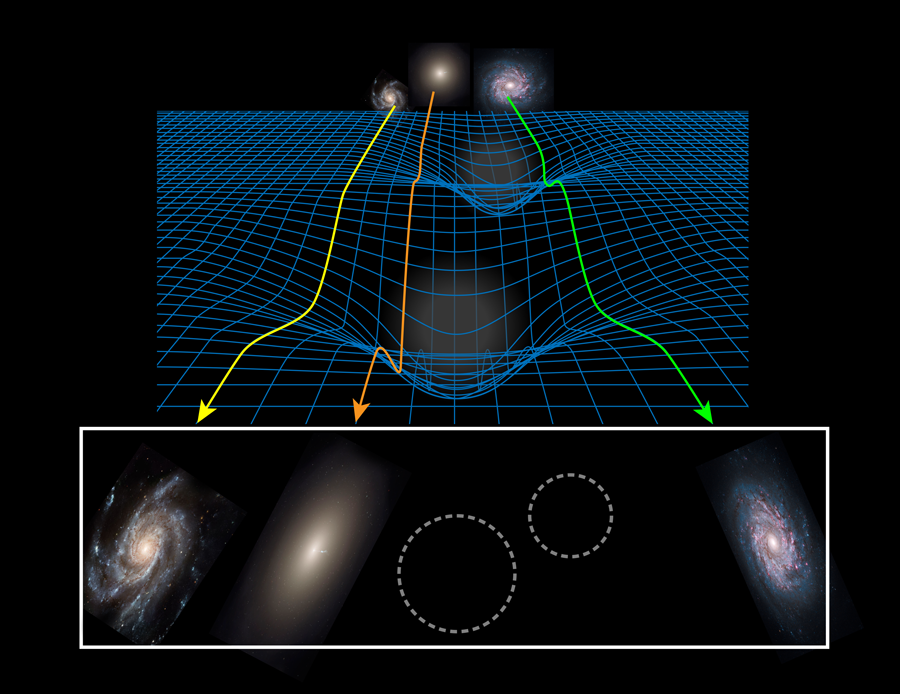Sky Survey Casts Light on the Dark Universe
If you talked to any cosmologist today, you would most likely witness two conflicting emotions. The first is quite self-congratulatory as the community has collectively nailed down the precise quantities of each component in the Universe, using multiple independent observations. The second is one of panic, when they admit that the major dark constituents of the Universe that are inferred to exist remain elusive. The Dark Energy Survey (DES) is one of three optical imaging surveys in this decade’s hot competition to uncover the true nature of the dark side of our Universe. One way to demonstrate the future potential of these surveys is to identify and map dense clumps of dark matter through the distortions they cause in the perceived shapes of background galaxies. Chihway Chang of the Swiss Federal Institute of Technology (ETH) in Zurich, and Vinu Vikram of Argonne National Laboratory, Illinois, present a map of dark matter from the first 3% of data from DES, which is observing the Southern Sky over a full five-year mission [1, 2]. This very first glimpse reveals just how powerful this new sky survey will become in its quest to understand dark energy, which is driving the acceleration of the Universe and thereby affecting the distribution of the dark matter that they have mapped.
Dark matter is invisible, but it makes up 84% of all the matter in the Universe [3]. We only infer its presence because of the effect it has on both the light and matter that we can see. In the early Universe, the dominant clumps of dark matter gravitationally attract the normal matter that will go on to form the galaxies that we can see today. Dark matter really dictates where and when galaxies form in the Universe.
Dark energy constitutes 68.5% of the total cosmic energy density of the Universe, apparently providing extra fuel to accelerate the post big-bang expansion of the Universe. Recent rapid expansion would make it hard for large-scale structures of matter to form and grow. Scientists hope to uncover the origin of dark energy by observing how it affects the growth of structures in the Universe over time.
Einstein’s theory of general relativity tells us that mass curves spacetime. As light travels towards us from the distant Universe, its path is bent as it passes clumps of matter. Imagine light emitted from two neighboring distant galaxies (see Fig. 1). As these two rays of light traverse the Universe, over billions of light years, they will both pass by the same structures of matter. Every time the paths of the light rays are bent during this journey, the images of those neighboring galaxies that we observe become distorted in the same way. In the most extreme cases, this “gravitational lensing” results in the galaxies being stretched out into long arcs. But in the majority of situations, the lensing effect is more subtle, causing galaxies to appear more elongated, or elliptical, in one direction. This results in an apparent alignment of galaxies in the same part of the sky. The more matter that the light has passed, the stronger the resulting alignment will be. The amount of distortion, and hence alignment, is usually quite small, so to see it we need to take some sort of statistical average of all the distant galaxies in a small patch of sky. With no matter, we would expect to find that our average of randomly oriented galaxies would look like a circle (i.e., with no preferred orientation). With matter, however, we’ll find our average of lensed-aligned galaxies to be an ellipse.
We can think of the induced galaxy alignment as a faint signature that dark matter has written across the cosmos to tell us exactly where it is and how much of it there is. It’s precisely this signature that the Dark Energy Survey has observed with the 4-meter Blanco telescope in Chile. In two companion papers, Chang and Vikram and their colleagues present imaging data of a contiguous area of sky spanning 139 square degrees. This is roughly the area of a patch of sky covered by your hand held at arm’s length. By analyzing these images containing 2 million distant galaxies, the researchers are able to map dark matter across this region of space.
The DES dark matter map is not the first of its kind. Several pioneering analyses have come before it, most notably the Canada-France-Hawaii Telescope Lensing Survey [4], which used 4 times the number of distant galaxies that DES used to map an area of similar size but at higher resolution. The two teams have reached the same conclusions, though: The luminous matter that we can see is housed within the dark matter structures that we cannot see, and this dark matter forms a cosmic web of filaments, knots, and voids. As it continues collecting and analyzing data, DES will be able to map how these dark matter structures evolve over time.
At this point we should address just how challenging this observational measurement is. The change that we wish to detect in galaxy ellipticity induced by the dark matter is of order 1%, an almost imperceptible amount considering the difference between a circle and a line would be a change in ellipticity of 100%. When the light from these distant galaxies reaches Earth, the atmosphere, telescope, and camera induce an additional distortion in the ellipticity of the observed galaxies of the order 10%. Luckily there are stars in our own Milky Way Galaxy that act as point sources, allowing us to model this terrestrial distortion. Much of the painstaking work presented by Vikram and Chang convinces us that the correction that they apply is sufficiently accurate, and furthermore, that the design of DES is optimized to minimize this source of error in their analysis.
The next few years will be extremely exciting for dark Universe enthusiasts. When the Dark Energy Survey completes its data collection, it will be able to map dark matter over 5000 square degrees using gravitational lensing. Two rival surveys—the European Kilo-Degree Survey [5], and the Hyper-Suprime Camera survey [6]—will both image a smaller area, totaling 1500 square degrees of the cosmos, but with higher precision and depth. These three international collaborations will use their pinpointing of dark matter to confront different cosmological theories that try to explain the mysterious accelerating expansion of our Universe. The acceleration, fueled by dark energy, affects the clumpiness of the dark matter distribution. Mapping mass across cosmic time therefore enables the measurement of dark energy properties at different epochs. A measurement that revealed a time evolution in the dark energy would rule out the current baseline theory that dark energy arises from some universal cosmological constant. The work by Vikram and Chang is just the thrilling start. Expect to see great advances in our understanding as the data collected by these three major new facilities grows.
This research is published in Physical Review Letters and Physical Review D.
References
- V. Vikram et al., “Wide-Field Lensing Mass Maps from DES Science Verification Data: Methodology and Detailed Analysis,” Phys Rev. D 92, 022006 (2015).
- C. Chang et al., “Wide-Field Lensing Mass Maps from DES Science Verification Data,” Phys. Rev. Lett. 115, 051301 (2015).
- P. A. R. Ade et al. (Planck Collaboration), “Planck 2015 Results. XIII. Cosmological Parameters,” arXiv:1502.01589.
- L. Van Waerbeke et al., “CFHTLenS: Mapping the Large-Scale Structure with Gravitational Lensing,” Mon. Not. R. Astron. Soc. 433, 3373 (2013).
- J. T. A. de Jong et al., “The Kilo-Degree Survey,” The Messenger 154, 44 (2013).
- S. Miyazaki et al., “Properties of Weak Lensing Clusters Detected on Hyper Suprime-Cam 2.3 Square Degree Field,” Astrophys. J. 807, 22 (2015).





